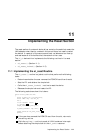
10
Implementing a Watchdog Section
Network device drivers can take advantage of the watchdog timer. The
network layer implements this mechanism to ensure that the network device
is transmitting data. The driver starts the watchdog timer when it sends
a transmit request to the device. After it receives the transmit completion
interrupt, the driver stops the timer. If the interrupt never happens, the
timer expires and the driver’s watchdog interface is called.
The watchdog timer is implemented using the if_timer member of the
device’s ifnet data structure. The value stored there represents the
number of seconds to wait for the transmit to complete. Once per second,
the network layer examines this value. If it is 0 (zero), then the timer is
disabled. Otherwise, the value is decremented, and if it reaches 0 (zero), the
driver’s watchdog interface is called.
The watchdog section of a network device driver is an optional interface, but
we recommend that all network drivers have one.
The if_el device driver implements a watchdog( ) routine called
el_watch( ), which performs the following tasks:
• Sets the IPL and obtains the simple lock (Section 10.1)
• Increments the transmit timeout counter and calls the
el_reset_locked( ) routine to reset the unit (Section 10.2)
• Releases the simple lock and resets the IPL (Section 10.3)
10.1 Setting the IPL and Obtaining the Simple Lock
The following code shows how to set up the el_watch( ) routine and shows
how el_watch( ) sets the IPL and obtains the simple lock.
static int el_watch(int unit)
{
register struct el_softc *sc = el_softc[unit];
register struct ifnet *ifp = &sc->is_if;
int s;
s = splimp();
1
simple_lock(&sc->el_softc_lock); 2
1 Calls the splimp( ) routine to mask all LAN hardware interrupts.
On successful completion, splimp( ) stores an integer value in the s
variable. This integer value represents the CPU priority level that
existed prior to the call to splimp( ).
Implementing a Watchdog Section 10–1


















